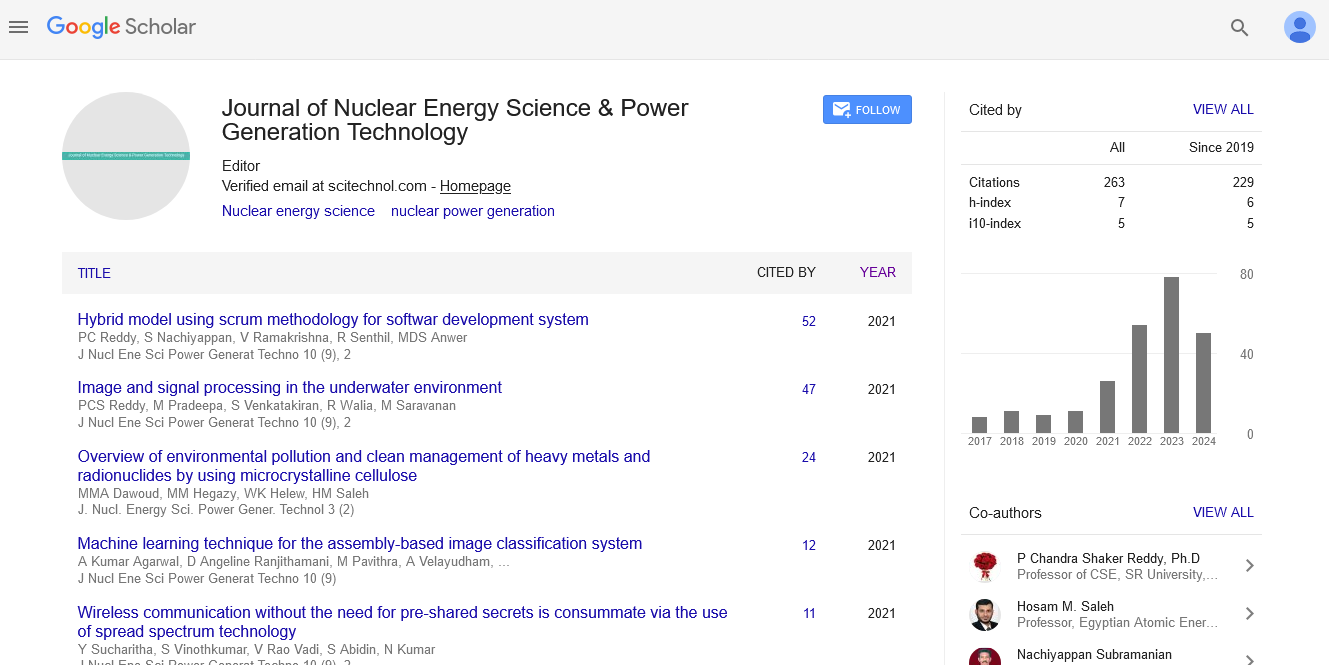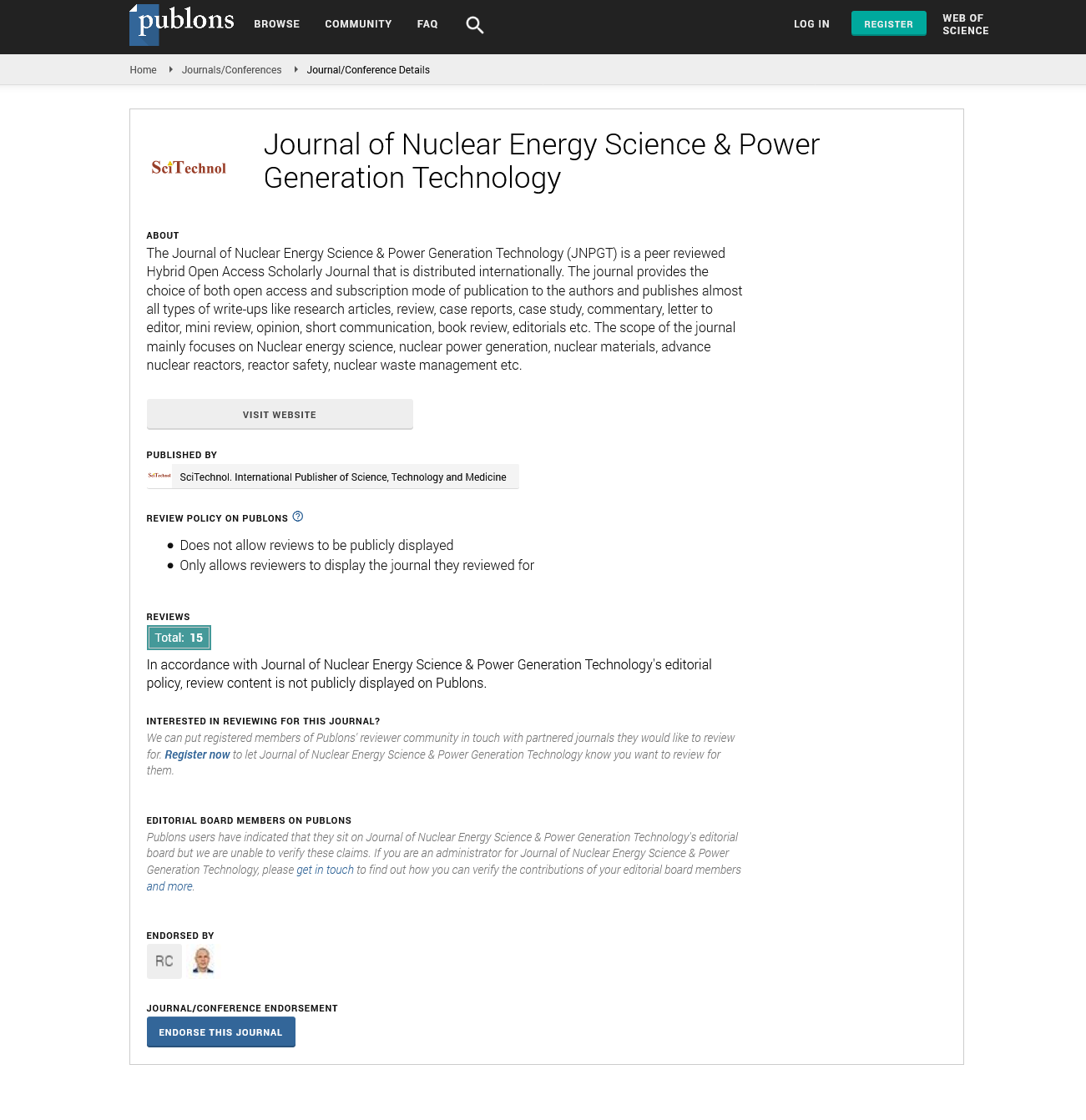Perspective, J Nucl Ene Sci Power Generat Technol Vol: 13 Issue: 5
Evaluating the Viability of Coal- To-Nuclear Conversions: Technological and Environmental Perspectives
Lisa Xin*
1Department of Energy and Power Engineering, Xi'an Jiaotong University, Shaanxi, China
*Corresponding Author: Lisa Xin,
Department of Energy and Power Engineering,
Xi'an Jiaotong University, Shaanxi, China
E-mail: lisa_xin-12@gmail.com
Received date: 26 August, 2024, Manuscript No. JNPGT-24-150415;
Editor assigned date: 28 August, 2024, PreQC No. JNPGT-24-150415 (PQ);
Reviewed date: 11 September, 2024, QC No. JNPGT-24-150415;
Revised date: 18 September, 2024, Manuscript No. JNPGT-24-150415 (R);
Published date: 25 September, 2024, DOI: 10.4172/2325-9809.1000419.
Citation: Xin L (2024) Evaluating the Viability of Coal- To-Nuclear Conversions: Technological and Environmental Perspectives. J Nucl Ene Sci Power Generat Technol 13:5.
Description
The global energy landscape is undergoing a significant transformation as the need for cleaner and more efficient energy sources grows. Coal plants which support industrial power generation are increasingly being inspected for their environmental impact, particularly due to their substantial greenhouse gas emissions. For decades, coal plants were the dominant source of electricity generation worldwide. However, their contribution to global warming through high carbon dioxide emissions has led to growing concerns about their environmental sustainability. In addition to air pollution, coal mining operations have significant impacts on ecosystems, water resources and local communities. Many governments have responded by implementing stricter regulations on emissions and pushing for renewable and low-carbon energy alternatives.
Despite the decline in coal’s popularity, many countries still depend on coal plants to meet their energy demands. Shutting down these plants shortly could generate energy shortages and disrupt local economies, especially in regions dependent on coal mining and related industries. As a result, a gradual transition from coal to cleaner energy sources is essential to balance environmental needs with economic realities. One innovative approach to transitioning from coal to nuclear power involves repurposing existing coal plant infrastructure to accommodate nuclear reactors. Many coal plants have valuable infrastructure, such as cooling systems, grid connections and transportation networks that could be adapted for use in nuclear energy production. By utilizing these properties, the cost and time required to build new nuclear facilities could be significantly reduced.
The concept of "coal-to-nuclear" conversion has gained traction in recent years, with several studies and projects exploring its feasibility. One of the most promising technologies for such conversions is the use of Small Modular Reactors (SMRs). Unlike traditional large-scale nuclear reactors, SMRs are smaller, more flexible and easier to install. They can be deployed at former coal plant sites, captivating advantage of existing infrastructure while minimizing the environmental footprint of new construction. Transitioning from coal to nuclear energy provides several key environmental and economic benefits. Primary nuclear reactors produce minimal air pollution and no greenhouse gases during operation, helping to moderate climate change. Furthermore, nuclear power generates far less waste compared to coal plants, which produce large amounts of toxic ash and contribute to air and water pollution.
Economically, repurposing coal plant sites for nuclear reactors could provide new job opportunities in regions that have historically relied on coal mining and power generation. While the nuclear industry requires highly skilled workers, it also provides long-term stability. In addition, the construction and maintenance of nuclear reactors could revitalize local economies and produce a new energy export market. While the benefits of transitioning from coal to nuclear energy are significant. Public perception of nuclear energy remains mixed, with concerns about safety and radioactive waste disposal. High-profile incidents such as the Fukushima disaster have raised awareness of the potential risks associated with nuclear power. However, advances in reactor design and safety protocols have greatly improved the safety of modern nuclear reactors.
Conclusion
Another challenge is the cost of building and maintaining nuclear reactors, which can be high compared to other energy sources. While repurposing coal plant infrastructure can help reduce costs, significant investment will still be required to bring these projects to completion. Governments and private investors will need to collaborate to ensure that the transition to nuclear power is economically viable. The transition from coal plants to nuclear reactors presents a unique opportunity to provide the pressing need for cleaner, more sustainable energy. By repurposing existing coal plant infrastructure and adopting advanced nuclear technologies such as small modular reactors countries can reduce their carbon footprint while maintaining a stable and reliable energy supply. While challenges remain, the environmental and economic benefits of nuclear energy make it a viable alternative to coal, providing a path toward a cleaner and more strong energy future.
 Spanish
Spanish  Chinese
Chinese  Russian
Russian  German
German  French
French  Japanese
Japanese  Portuguese
Portuguese  Hindi
Hindi 

